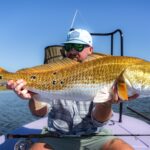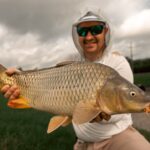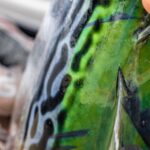
Louisiana Bull Reds Up for Harvest Again: H.B. 604 Must Not Pass
Photo Credit: Carter Abramson | Trevor Johnson Every now and then, we encounter something so
One of our biggest fears with offshore wind (OSW) development is the possibility that fishing guides and recreational anglers won’t be able to fish or navigate around these offshore structures. We’ve heard assurances from developers that they don’t plan to prevent access from the OSW arrays (outside of temporary construction and maintenance exclusionary zones), and that regulatory entities (BOEM and the Coast Guard) don’t plan to restrict access either. However, a formal policy was lacking.
So, this past fall, Congressman Paul Tonko’s office reached out to us for input on OSW legislation that the New York Congressman was developing. We were quick to bring up this concern–as well as some other thoughts. The legislation, titled “The Offshore Energy Modernization Act,” was introduced at the end of the 117th Congress in December 2022 and would bring much needed clarity to the rapidly-developing OSW industry. There are several provisions that we were excited by, some we had some reservations about, but we were most encouraged by Section 10:
“It is the sense of Congress that fishing and boating access in and around offshore renewable energy projects will be maintained with narrow exceptions for construction and maintenance activities.”
While this legislation has yet to be re-introduced in the current 118th Congress and is not enacted law yet, we were thrilled that Congressman Tonko listened to the concerns of the recreational angling community and included this provision in his legislation.
“Offshore wind development presents both an opportunity to increase the Nation’s renewable energy portfolio but also potential challenges for fisheries and marine ecosystems,” said Tony Friedrich, Policy Director and Vice President of the American Saltwater Guides Association. “This legislation will address many of those challenges. The American Saltwater Guides Association thanks Congressman Tonko for bringing much-needed clarity to offshore wind development in the United States, namely by ensuring recreational fishing and boating access in offshore wind arrays, looking at habitat enhancement opportunities in the decommissioning process, and finally establishing a revenue-sharing framework for offshore wind that will fund coastal conservation efforts.”
Tony’s quote was included in the Congressman’s press release. We look forward to working with Congressman Tonko’s office and others in the 118th Congress to ensure that OSW development progresses responsibly for the recreational angling community and marine ecosystems.
Cover picture by Dustin Stevens.

Photo Credit: Carter Abramson | Trevor Johnson Every now and then, we encounter something so

This past weekend, ASGA proudly sponsored the Dirty Carp Tournament in Louisiana — and no, you didn’t misread that.

After years of data pouring in from The Albie Project, advocacy, persistence, and support from

This morning, the Connecticut Environment Committee held a hearing on House Bill 6248, a bill
We rely on our members and donations to keep fighting for a sustainable tomorrow in marine conservation.
GIVE THE GIFT OF FISHERIES CONSERVATION THIS HOLIDAY SEASON. SHOP ASGA GOODS THAT FUND FISHERIES RESEARCH & ADVOCACY CAMPAIGNS
JOIN ASGA IN CALLING FOR CRITICAL MANAGEMENT ACTION AFTER YEARS OF SPAWN FAILURES & POOR MANAGEMENT.
By using this website, you agree to our use of cookies. We use cookies to provide you with a great experience and to help our website run effectively. To learn more, please review our privacy policy.
2 Responses
Reading your post above I am feeling you are not against offshore wind turbines being built along our coastline. And while I see the upside of potential structure and fish holding habitat, I also see many downsides.
I read that the towers will be si gle pylons with minimal rubble, so not much structure. I also read they will be treated with antifouling coatings to prevent marine growth. Not really conducive to fishing.
Upon further research I’ve read that these wind towers create a lot of vibration, noise, and electromagnetic fields. Also not great for fishing, or migratory species.
Then of course there is the recent spate of deaths among the whales and dolphins. I’ve also read posts from commercial fishermen stating that pretty much everything below where the wind survey ships are running with their “sonar” in dead or dying. And where these ships have been harassing the commercial fleet and destroying their equipment.
Of course NOAA and other government agencies say they’ve conducted tests on the dead mammals, but I find it hard to believe the findings aren’t skewed to their wants.
So, my question is, where does ASGA stand with the push for wind turbines off our coast? And if you are for it, why?
And please don’t tell me you are all for renewable energy. Wind power is not even close to being proven or reliable yet.
As a guide, and someone who has stood behind your organization, I would love an honest answer.
Frank,
Our apologies on not approving this comment sooner. We got a lot of feedback on the website recently and this was pushed down a page.
Our #1 concern from the start was that something would happen and fishermen would be denied access to fish these areas. This blog was only to show that we are working on that at the highest level of government to ensure this doesn’t happen. It is one thing to build these structures. It is another to say “You can’t go here anymore”. That happened to some areas post 9-11. It could happen again.
Here’s our position in the nutshell. The process is moving very fast. There is a lot we don’t know. ASGA isn’t a big organization but we have committed countless resources to being part of this process. We do everything we can to make sure that we are a voice for the resource. If we aren’t involved in it every step of the way, we are going to get steamrolled. We always say that “if you don’t have a seat at the table, you are on the menu”. There are no illusions at ASGA that wind turbines will save the world. We aren’t that kind of group. There is a benefit in having another source of energy, not to replace other sources, but to add to the overall ability of our country to produce energy on our own.
In regard to the structure, we are working with other groups to install fish habitat that will serve as scour protection. The vibration issue… Vibration represents lost dollars to the developers. Every bit of vibration is wasted revenue. The developers want the least amount of vibration possible for this reason. That isn’t saying there aren’t problems. It is just a fact that the developers are in this to make money and vibration=money lost.
Hope this answers your questions, Frank. If you have any other concerns, feel free to email us at info@saltwaterguidesassociation.org. I’d be happy to hop on a call with you if that is easier. We appreciate the past support and the question.